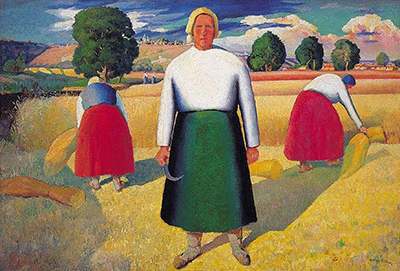Жницы, or Reapers, continues Malevich's focus on the lives of ordinary agricultural workers. This painting was produced in 1929, just a few years before his death, and is part of his second cycle of peasant paintings.
This painting forms part of the 2nd Peasant Cycle in which Malevich continued with much the same themes as content and inspiration but with a different stylistic approach. We find here a little more detail than in some of his other interpretations, with a main figure facing us, looking directly at the viewer. She is dressed in simple clothing entirely suitable for agricultural work. There is a tool in her right hand to confirm her occupation, whilst two colleagues behind her are hard at work, bending their backs to provide food for the nation. The tones of colour are bright and uplifting, and so this differs from some of the more real and honest depictions of farm work as delivered by several French artists in previous centuries. For example, one can recall the work of Gustave Courbet who contributed the likes of The Stone Breakers, The Peasants of Flagey Returning from the Fair and Young Ladies of the Village.
Malevich was forced in later life to tailor some of his work to avoid being imprisoned by the ruling Russian powers. He worked hard to find a style with which he was comfortable working but that also did not cause controversy, though this situation would certainly have caused sadness for him. Artists are not appreciative of being directed in how to work, particularly when it comes from people to understand very little about art itself. Sadly this situation is not uncommon and both extremes sides of the political world have dictated to creative people about how they should express themselves from time to time. Thankfully, in today's world most ideas are respected and debated, and even if ridiculed they are still entirely able to be expressed without fear of imprisonment.
Malevich is most famous today for his supremely abstract work, where minimalism is taken to extremes. This resulted in iconic paintings such as Black Square, Black Circle and Black Cross. That style would normally feature just two or three colours and leave behind some extraordinary artworks that would grab your attention and leave you wondering about what these simple shapes represented, if anything. Malevich would therefore vary his levels of detail and abstraction considerably across the different phases of his career, having initially been trained and influenced by the Impressionist and Post-Impressionist artists, who he respected but never felt that he wanted to go down that path himself. He was always destined to be more modern in approach, but varied his levels of abstraction with an eventual complete disconnect from reality through his Suprematist movement.




